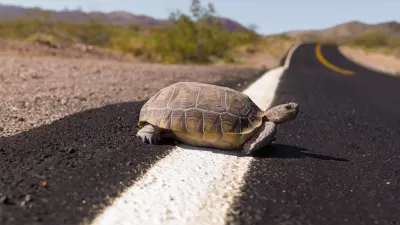Animal-vehicle collisions cause billions in property damage, hundreds of human deaths, and dramatic losses in animal populations every year. Monitoring migration and building for animals can make roads safer for everyone.

Writing in Governing, Matt Skroch explains the value of investing in wildlife crossings and other infrastructure projects that help urban and regional planners understand wildlife migration patterns and protect animals from traffic collisions.
According to Skroch, “These accidents lead to some 200 human deaths and 26,000 injuries each year, resulting in more than $8 billion in property damage, health-care costs and lost workdays, according to the U.S. Department of Transportation.” For the animals, and the industries that depend on them, the news is equally bad. “In Wyoming, for example, the mule deer population, which supports more than $300 million in annual hunting-related spending in the state, has decreased by 40 percent since 2000, due in large part to habitat fragmentation caused by roads and development.”
Yet Skroch writes that “Advances in research technology over the past decade have revolutionized experts’ understanding of how wildlife move across landscapes and are now helping to resolve wildlife-vehicle conflicts that are rising due to increased development.” Today, GPS collars and well-placed under- or overpasses can help researchers understand movement patterns and keep animals out of harm’s way.
“In the face of climate change, sustaining these landscape connections is more important than ever, as it helps provide greater ecosystem resilience for species that migrate between habitats,” Skroch argues. Federal officials have taken note. “On the federal level, the Infrastructure Investment and Jobs Act of 2021 includes billions of dollars over five years for wildlife and aquatic connectivity programs, along with $350 million for a new wildlife-crossing construction program.” In Los Angeles, the world’s largest wildlife crossing broke ground earlier this year.
FULL STORY: The Dreadful Toll of Wildlife-Vehicle Collisions — and What We Can Do About It

Alabama: Trump Terminates Settlements for Black Communities Harmed By Raw Sewage
Trump deemed the landmark civil rights agreement “illegal DEI and environmental justice policy.”

Study: Maui’s Plan to Convert Vacation Rentals to Long-Term Housing Could Cause Nearly $1 Billion Economic Loss
The plan would reduce visitor accommodation by 25% resulting in 1,900 jobs lost.

Planetizen Federal Action Tracker
A weekly monitor of how Trump’s orders and actions are impacting planners and planning in America.

Federal Homelessness Agency Places Entire Staff on Leave
The U.S. Interagency Council on Homelessness is the only federal agency dedicated to preventing and ending homelessness.

Restoring Northern India’s Himalayan ‘Water Temples’
Thousands of centuries-old buildings protect the region’s natural springs and serve as community wells and gathering places.

Milwaukee to Double Bike Share Stations
Bublr Bikes, one of the nation’s most successful, will add 500 new e-bikes to its system.
Urban Design for Planners 1: Software Tools
This six-course series explores essential urban design concepts using open source software and equips planners with the tools they need to participate fully in the urban design process.
Planning for Universal Design
Learn the tools for implementing Universal Design in planning regulations.
Caltrans
Smith Gee Studio
Institute for Housing and Urban Development Studies (IHS)
City of Grandview
Harvard GSD Executive Education
Toledo-Lucas County Plan Commissions
Salt Lake City
NYU Wagner Graduate School of Public Service





























